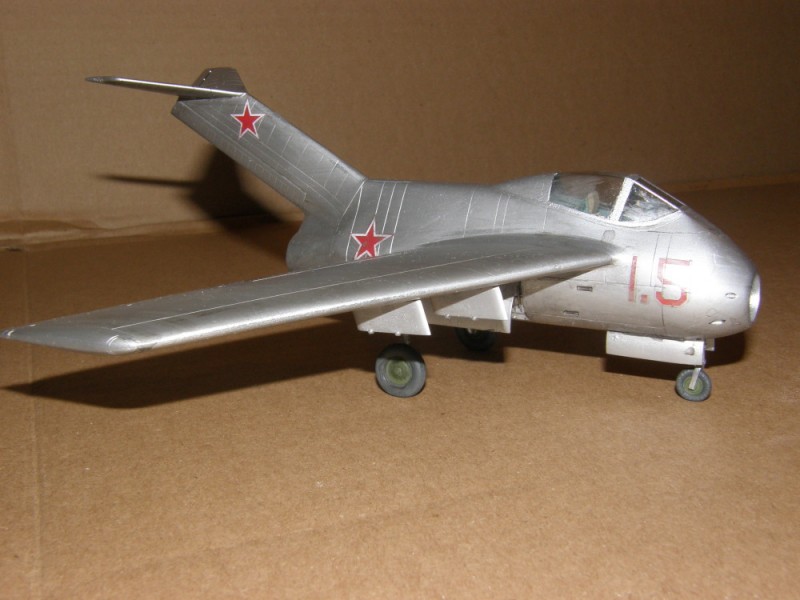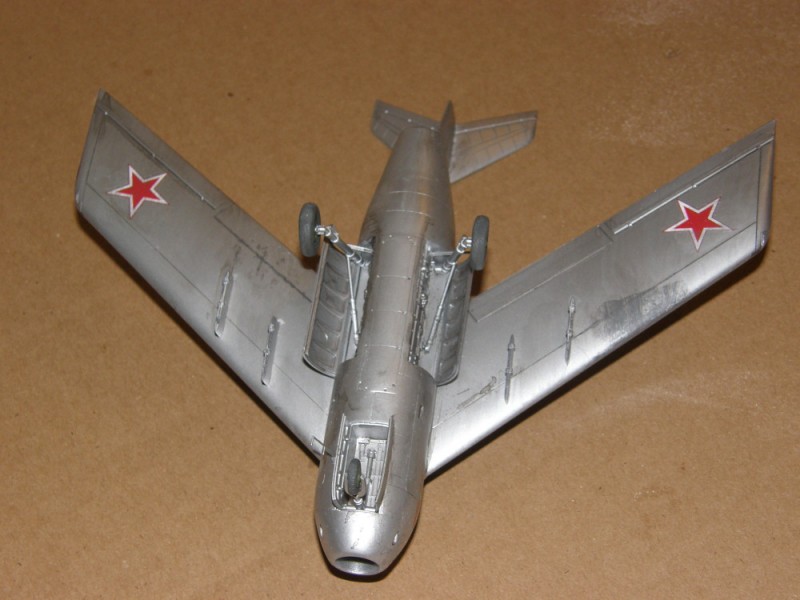
At end of Great Patriotic War, Glorious Soviet Army, fresh from their Glorious Socialist victory over forces of Fascism, returned to Motherland bearing gifts. Along with several countries, they freed thousands of reports, studies and blueprints from Fascist factories. These reports were studied by Soviet Academicians and ideas therein, finally freed from their Fascist Foremen, went on to help Soviet industrial might take its rightful place in post-war world.
Design Bureau of Artem Mikoyan and Mikhail Gurevich was tasked with creating Soviet Union's first practical jet fighter aircraft. Design work was well along with aircraft which would become MiG 9, but both Mikoyan and Gurevich knew that its straight-wing design would quickly render it obsolete. MiG designers in Advanced Projects Office (unofficially known as Работы Скунса or "office that smells", given its location downwind of cesspits), having read translated German research papers, were convinced that swept-wing design was necessary to take better advantage of thrust available from jet engines Glorious victorious Soviet Soldiers had also brought back with them, hidden in their duffle bags.
Needing design to succeed already obsolescent MiG 9 and working with captured German documentation, Mikoyan's design team rapidly produced drawings for what would become known as Mig e1.5 experimental fighter aircraft. This aircraft was considered to be too small and limited to be used as frontline combat aircraft, although it did have capability to be used as point-defence interceptor, and indeed it was used in this capacity for several years after its test program was completed, gloriously defending MiG OKB's cesspits from all known intruders.
e1.5 was small, tubby aircraft, with sharply swept-back wings set fairly high on barrel-shaped fuselage. Engine exhausted under equally sharply-swept vertical stabiliser, and was fed through nose-mounted intake. Stubby fuselage was selected to keep length of jet pipes to minimum, due to awareness that very long intake and exhaust pipes would cause airflow interference, reducing available thrust from already-overtaxed and inefficient copies of German Jumo 003 engine. This state of affairs was to continue until KGB, having duped Capitalist Rolls Royce Company into selling them their Nene engine for merely massive amounts of money, brought Soviet aircraft designers New Soviet Engine worthy of capabilities of their New Soviet Designs.
Horizontal stabilisers were placed at top of fin, extending their moment arm back far enough to establish positive pitch control. Forward-retracting main undercarriage was placed in fuselage below wings, which were too thin and set too high on fuselage for any practical installation. Nose wheel was placed in conventional well just below and behind intake. Two 37mm cannon were placed on either side of nose intake, again just behind intake lip. Spent cartridge casings were jettisoned overboard via two slots set just below leading edge of wing.

Each wing had two hard points set within first half of span. These were intended to allow testing of Soviet Union's first generation of guided missiles. Design was frozen quickly (simple enough process during Soviet winter) and work on prototype began in October of 1946, to take advantage of symbolic date of Glorious October Revolution of 1918.
Prototype MiG e1.5 was hand-built by skilled workers of Glorious Red Banner Tractor Fuel Pump Mounting Bolt Flange Plant No. 345, located in industrial city of Gor'kiy, several hours flying time East of Moscow. When it emerged into light of day, hypothetical observer (just before being hustled off to well-deserved KGB interrogation) could be excused for thinking that it bore striking resemblance to Kurt Tank's TA-183 design from last desperate months of Great Patriotic War. Mikoyan and Gurevich were quick to deny that they had merely copied Tank's design. They pointed out pointedly on many occasions that aircraft designed to do similar things invariably ended up looking much like each other. They pointed out that American F-80 and C-54 both had wings, fuselage and one or more engines. Similar aircraft look similar. QED. (In fact this principle of similarity was taken advantage of few years later when Swedish SAAB company produced their J-29 "Tunnan" fighter. Mikoyan and Gurevich were quick to denounce capitalist Swedes of espionage, charge that stuck and was pursued through Soviet Courts. SAAB was convicted in absentia and ordered to pay MiG several billion Roubles in damages. Since cowardly SAAB company did not pay, generous Soviet Government themselves made up shortfall.)
When pressed to show originality of their design work, Mikoyan and Geurevich's engineers showed their blueprints to Council of Deputies of Supreme Soviet in landmark secret closed-doors meeting. All present agreed in originality of drawings, some going so far as to say that swastikas could hardly be seen any more, so effective had Soviet erasures been. Once more, Soviet Design and free-thinking Soviet minds emerged vindicated.
MiG e1.5ís official first flight was held before members of Politburo on May 1st, 1947, auspicious date chosen to honour workers who had produced such advanced aircraft. It had been flown to Ramenskoye flight-test centre in secret one month before, its short range necessitating several fuel stops along way. Because jet fuel was not yet in quantity production, ground crews had to requisition every kerosene lantern in 500 Kilometre radius in order to provide sufficient fuel for flight. Given that prototype was State Secret, this meant that each of lanterns' owners, refuelling technicians, airport personnel and passing donkey all had to be arrested and deported to Siberia to keep secret of this powerful new aircraft from falling into hands of cowardly Capitalist spies. Plan was developed to return arrested people to their homes and factories after public announcement of aircraft was made following its first flight, but backlog in processing paperwork arose because clerk responsible for processing arrest releases had been among those arrested. Prisoners were finally released as part of General Amnesty declared on occasion of 50th anniversary of October Revolution in 1968.
e1.5 was successfully flown in front of entire Politburo, who watched gloriously from safety of bomb shelter with closed blast shutters in case emergency arose. After stress of first flight was over, aircraft settled into routine of testing, broken only by frequent fuel stops caused by its 15 minute endurance. Long range testing was unable to be carried out, preventing e1.5 from being declared suitable for combat.
Missile testing proceeded as soon as designers were satisfied that e1.5 could fly straight and level for more than 30 seconds two times out of three. This milestone was reached quickly, after only two years of testing. Several types of missiles, also developed from expanding on German research papers recovered by glorious Soviet Army at end of reat Patriotic War, were tested. Missiles were declared successful as soon as they could leave launching aircraft, ignite without explosion, not dive immediately into ground nor soar directly towards sun, and detonate within near vicinity of target aircraft. In this case "near vicinity" was defined as "being close enough to startle target's pilot little bit".
After finishing its test program, and providing vast reams of data to MiG engineers which was quickly used to develop immortal and glorious MiG 15, e1.5 was returned to control of MiG OKB, who, seeing its potential as point-defence interceptor, used it for many years to protect their offices.

e1.5 survives to this day in rear lot of Monino Museum near Moscow, given pride of place, befitting its humble origin, next to facility's cesspool. Grass has been sadly neglected and has grown quite tall, necessitating some searching, but diligent explorer will be well rewarded by sight of this important artifact. Remember to wear rubber waders during search; some wanderers who neglected to take proper precautions have found cesspool instead.
The Kit
AMTech released a "Luft '46" kit of the Ta283 Huckbien in 2001. The kit was produced to the standards of a mainstream kit, with fit and detail rivalling that of a Tamiya kit. Given the usual quality of Luft '46 and other "What If" kits, this was a major departure for AMTech. This boxing was Tamiya's release which included their wonderful Kettenkrad which had first seen the light of day in the first boxing of the Me 262 kit.
The Build,
Since this was going to be a light-hearted "What If", I didn't spend too long on the details. AMTech moulded the canopy shut, and although it would only take a few moments with a razor saw to open it, I decided that I would leave it closed, rendering the choice of detail in the cockpit moot. The canopy is nicely clear, so I decided that a careful painting job and a generic Sutton harness from the Parts Drawer would be sufficient.
There are few traps to avoid in building this kit. The fit is very good with parts almost clicking into place. Any problems are the result of my hamfistedness rather than the fault of the mouldings. There is no indication of the need for noseweight, but being a cautious woman, I superglued some lead shot into the nose bowl and in the left side of the fuselage once the cockpit and nose gear well were glued in place. Those two parts are the most fiddly of the entire build. Be careful to get them aligned so the right fuselage half can fit properly. Once those parts are installed, there isn't much room in there for weight so one hopes that the main gear are far enough aft to allow what weight I could cram in to hold the nose down. I glued a trifle too many shot inside the nose bowl, which caused the biggest fit hassle I encountered when they fouled on the front of the nose gear well. I managed to squeeze everything together except for a small gap between the nose bowl and one side of the fuselage at the nose gear well. I used a sliver of sheet plastic to shim the gap. I chose to install the blanking plate on the underside of the fuselage rather that the well supplied for the drop tank. The fit of this piece was a little tight and I had to resort to sanding it flush after the glue set.
Painting.
Soviet prototypes came in any colour you liked as long as it was bare metal. Since this was a quickie build I used a spray can of Testors silver, and buffed random panels with SNJ powder before the paint had completely set. Since Soviet aircraft were gloriously well maintained by conscripted workers and then left to rot out in the weather for decades, I dirtied the kit up with a wash of blackish-brownish acrylic "muck" custom mixed for the occasion and smeared it all over with rubbing alcohol after it dried. Decals were Soviet stars and numbers from the decal stash.
All hail glorious advancement of Soviet Technological progress, and not at all merely copy of German aircraft created years before.

Disclaimer: No actual history was harmed during the writing of this document.














